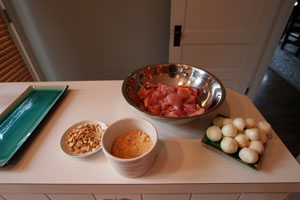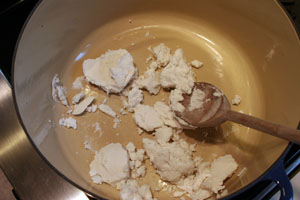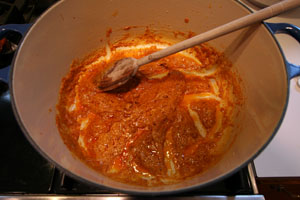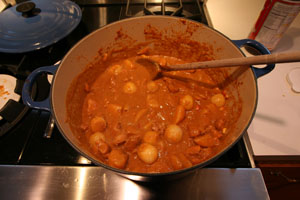Ever wanted to make that perfect Thai curry? Read on and I'll give you step-by-step instructions on how to do so.
 The Ingredients:
The Ingredients:
- 1 lb. boneless chicken thigh meat, cut into bite-size chunks
- 1-2 cups coconut milk
- 3-4 Tbs. massaman curry paste
- 3-4 Tbs. unsalted roasted peanuts, ground finely
- 1 medium-size potato, cut into 1 1/2-inch cubes
- 10 baby pearl onions, skinned
- Fish sauce
- Slivered fresh hot thai chillies
- 1-2 tsp. tamarind juice
- Palm Sugar
(Recipe from "It Rains Fishes" by Kasma Loha-unchit)
Shopping:
Don't just pop out to QFC or Safeway and grab any old ingredients. You need the right fish sauce, the right cocount milk and the right curry paste to make this a success. Also, even though you might gross out at thigh-meat – get it – it will make your curry so much better than chicken breast.
Part 1, the basics:
[don't forget you can click on the pictures for close-ups]
The night before, put a can of coconut milk in the fridge. This will allow the cream to separate from the watery fluid of the milk. Take it out of the fridge and use care not to turn it over, open the top of the can and you should have thick cream ontop.
Next, prep all the ingredients before you get started. The bulk of Thai cooking is in the prep..
Spoon out about 2/3 of a cup of coconut cream and put into a heavy bottomed pan. On medium-high heat, bring the coconut cream to a boil.
• Keep a close eye on it and in a few minutes, it will bubble and start secreting oils. At this point it will start to let off a fragrant odor.
• Reach for your massaman curry paste and drop about 3 tablespoons of it into the now fragrant coconut cream. Stir in well to blend into a thick paste.
• Keep boiling the paste and ˜fry' the curry paste for a few minutes, helping unlock it's flavours. After a few minutes, your guests will be wandering into your kitchen saying Wow. That smells fantastic". Beat them back with a wooden ladle and move on.
• Add in 3-4 tablespoons of ground unsalted roasted peanuts and maybe a ½ cup of coconut milk to form a thick creamy sauce. Â
• Toss in the chicken and sauté on medium-high heat until the meat is no longer pink.
• Add the rest of the can of coconut milk, the potatoes and pearl onions. Stir well to mix and cover and simmer for about 8-10 minutes until the potatoes are just cooked. A good test is to poke the spud with a knife until it can easily slide in.
• Once cooked, your curry should look something like this. The most critical step is next – balancing .
Part 2: The makings of a curry guru.
If you have tried to taste your delightful smelling curry, you probably noticed it tastes like crap at this point. The art of making Thai curries is in this final step - balancing the curry.
There are a few key tastes you are trying to balance out: salty, sour, sweet and hot. The perfect balance is personal preference. I like my massaman hot, slightly salty, slightly sweet with a hint of sour. If you order this dish at a Thai restaurant in Seattle - you'll get mostly sweet - overbearingly so. Play around and figure our where your tastes are.
Describing in words how to balance is not easy. This is by far one of the most important lessons you get in cooking with Kasma: tasting first hand what is right, and what is not right. Don't worry if you screw up and make it too salty - you can always fix a curry by adjusting the other ratios. So where do these flavours come from?
- Salty == fish sauce
- Sweet == palm sugar
- Sour == tamarind
- Hot == curry paste and fresh thai chillies
Here's how I balance:
- First of all, establish the heat level. This is mostly set by the amount of curry paste you used and also by throwing in enough thai chillies to taste. Thai chillies are hot little buggers, so go easy on them. Dip a spoon and taste your curry sauce. It won't taste that great yet. If it feels hotter than you want – don't worry – the sugar will cut and smooth out the heat later on. If its not hot enough, toss in some chilies. If you are serving to a mixed group of heat-tolerance, ease up on the heat and compensate with some prik nam plah at the table.
- Now lets define the salt. Grab your big fish sauce bottle. Hopefully you were able to find a good brand like "Golden Boy", which is not too salty of too fishy. Slap it in 3-4 tablespoons should get you going (less if you got an inferior brand). Give it a taste now, it should taste quite salty. Not to worry, we'll soon fix that.
- Add the tamarind. A couple of teaspoons and then taste again. You should start to sense the hints of sour coming through over the saltiness. Things will still be very salty. Keep adding until you get the hint, tasting after each addition.
- Now for the start of the magic, you are about to transform the taste of your curry. Start adding the palm sugar. A couple of tablespoons should get you in the right direction quickly. You'll notice how the consistency of the curry changes slightly as the sugar dissolves. Taste it and it should start to counter act that salty taste, smooth out the heat and start going in the sweet direction.
- Keep adding sugar until you feel it's on the edge, or starting to get too sweet, then bring back the fish sauce, etc.The trick is to find that knife-edge balance between salt and sweet while still retaining that microscopic hint of sour from the tamarind.
Serve with steamed jasmine rice and let your guests squeal with excitement. You, my friend, have entered the realm of the "glory chef".










Pingback: Massaman Curry » AlexHopmann.com
hey brett me and my girlfreind have used your recipe about 3 to 4 times already we love it! cheers on a good recipe. we also love yr little comments about beating someone back with the wooden ladel. got anymore Thai recipes? ive tried pad thai everything came out right,except the sauce was missing some of that punch 🙁 help me
The book this recipe came from was “It rains fishes” by Kasma Loha-Unchit. It’s an awesome book with tons of great recipes. I think there’s a good pad thai one in there too – but it’s very traditional thai street-food style – so it won’t be like the reddish stuff (with ketchup) you get in restaurants here.
It’s out of print, and amazon has used ones selling for $80!
http://www.amazon.com/Rains-Fishes-Legends-Traditions-Cooking/dp/0876543565
But I beleive you can order direct from Kasma for the normal price, if they have some left. Their website is:
http://www.thaifoodandtravel.com/irf.html
I’ll try and post another recipe when I can – but they take a lot of time to write up 🙂
Hi Brett,
Used your recipe last night…IT WAS WONDERFUL!!! My kids even loved it. Had to make a few changes due to not having all ingredients on hand (it’s a long way to downtown KC to the Asian market…I try and stock up when we’re there), but even with the subs it was still great! Can’t wait to try it as you wrote it…good quality fish sauce and tamarind (I used a real high quality lime juice and Taste of Thai fish sauce…but it was still wonderful)
Karen
Thanks for the post, Brett. I’ve actually been trying out various thai curries this past month and didn’t try the MaePloy coconut milk. I’ll definitely try it out this week. Also, I tried the Maesri brand of Thai curry pastes and it is PHENOMENAL. What are your thoughts on curry paste varieties?
Mae Ploy pastes are the one that is most common here in Seattle. Like this one: http://importfood.com/cpmp1406.html. I haven’t experimented with other brands too much – as they are very good.
If I have the time, you can’t beat making the paste from scratch. A nice beef paneng current is spectacular with home-made paste. The flavours and texture are just incredible and impossible to replicate with a store bought paste.
this recipe was yum yum yummmmmmmmmmmmmyyyyyyy… I do not have to go to my favorite Thai restaurant anymore give me more recipes….thank you for thsi one.
Pingback: Brett on Stuff » Freezer-bag Thai Green Curry
hi Brett,
i wish i found your website before i cooked my curry! the other recipe i found calls for way too much tamarind, so my curry became way too sour. a coworker recommended me curry paste made by Maesri, and it is better than other ones i’ve tried. i haven’t used Mae Ploy curry paste. i wonder which one is better…
We cooked this dish for our the main meal at the weekend. Everyone adored it, for certain I will be serving it frequently from now on, it really is nice to uncover different ideas for recipes in addition to straightforward techniques to cook them. Thanks for providing them.
Hi Brett,
Thanks for the tips on how to ‘fix’ a curry. I combined a few different recipes, and in one there were a few typo’s that I didnt pick as Asian is not my normal style of cooking. Since I normally cheat and use packet mixes, I was unsure but stuck to it anyway.. Well lots of $$$, dishes and time later, my dish (at first taste) was a disaster 🙁 But with a few additions and some discarded potato, my dish is (not perfect) but definitely edible! Thank you 😀
Brett,
Thanks for the recipe. This is my wife and my favorite Thai curry. We’ve been trying to figure it out for about 3 years. This is definitely the one! We added slivered red pepper and pineapple right at the end and wowsers!
Merci bien!